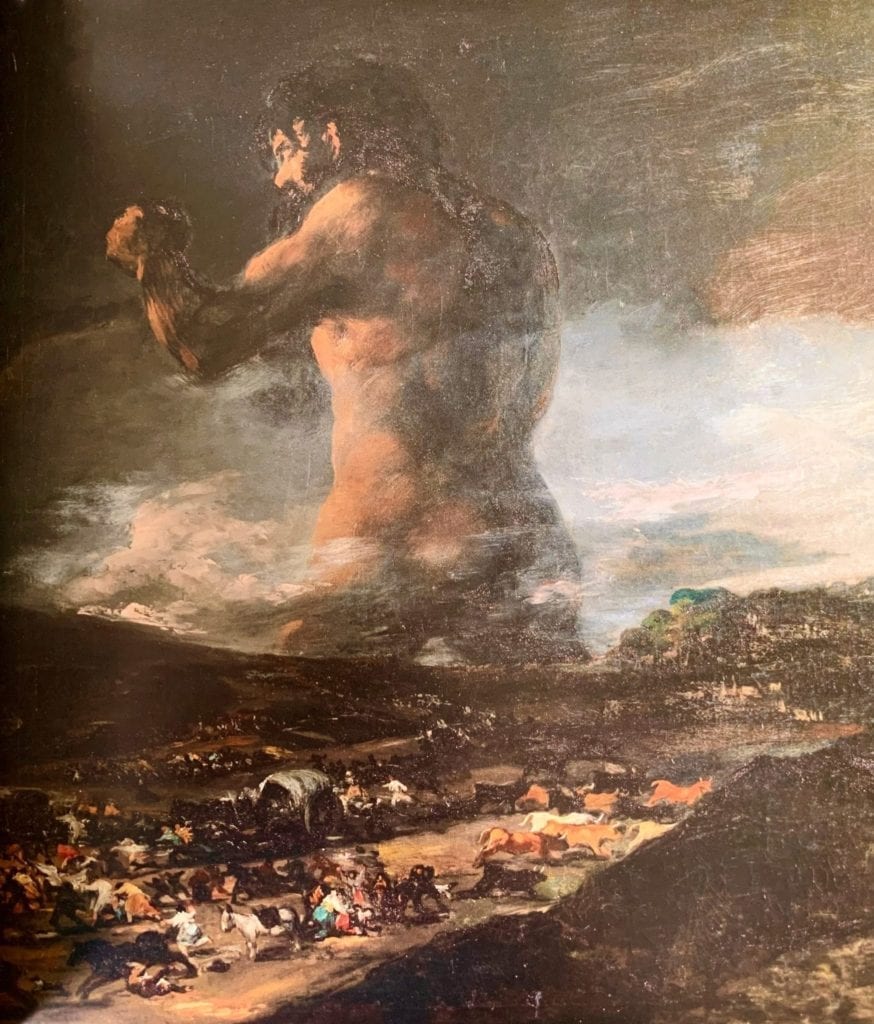An eerie mystery permeates The Colossus by Francisco de Goya. That’s because even though we know a lot about this historic work, mastery lies in its subtle imagery. Clouds tickle the looming giant and disguise details. But even more important, they bring his meaning into question.
Does he protect the people below? Or is he what they fear? It could be both. He’s naked, as fear itself is often described. The giant also hovers over the scene like a cloud himself. But he grounds the otherwise dynamic composition. He’s solid and sure, the opposite of Spain’s frantic figures below.
Click below for the podcast version of this post.
Spanish painter Francisco de Goya created The Colossus during Napoleon’s siege of Spain. So, many think El Gigante is the incompetent Fernando VII of Spain or Napolean. These were the major players wreaking devastation on Spain at the time of this work. Fernando and Napolean both had colossal egos. They were also aggressive; a lot like this ready-to-punch giant. If we choose to see The Colossus figure as one of these leaders, he’s not playing the protector. That’s because neither of them shielded the Spanish from danger.
In many ways the giant looks like a defender of Spain. That’s in large part because he has his back to them and us. He’s facing off with someone or something that requires full attention. The giant raises a fist to fight. This clenched hand represents the painting’s emotional core. It’s terror. The frenetic figures below show panic and chaos as well. They’re the vulnerable side of fear. Our giant, though, reveals the powerful part. Rather than run he stands to face fear head on.
Amorphous Fear & the Unknown
Take a closer look at The Colossus and the origin of danger isn’t the only mystery. We can’t see what the giant does. That’s confusing. But what we can see also confuses. It doesn’t make visual sense. He seems to rise out of the ground. Even with the mountains behind him, no cliff is that steep. There’s not enough room in this world for his giant legs. Is he standing in a different realm? This confusion represents another element of fear. Humans fear the unknown. We’re untethered by confusion. It unleashes our inner colossus. Or on a bad day it may even scatter our villagers within. People often panic in the face of confusion.
We don’t know if these freaking out figures fear The Colossus. It could be that they fear whatever he faces. The only thing we know for sure is that everybody in this painting feels afraid. From the mythical giant to the oxen racing off to our right – it’s terror terror everywhere. The amorphous standing of the giant represents our fear of the unknown. He’s ungrounded and seems to float in the clouds naked like some sort of furious angel.
It’s valid to see The Colossus as a threat. But viewing him as a protector makes just as much sense. This painting’s a masterpiece because it works both ways. We learn about ourselves with each interpretation. You can give the story a happy ending or the same portrait could convey a tragedy. It’s all in how you choose to see it. The fear could be real or representational.
When Goya painted this, between 1808 and 1812, he was old, deaf, and lonely. War ravaged Spain while his life played out its final act. Yet his masterpiece shows us Goya’s strength. He’s still fighting. There’s hope in those Spanish hills. It’s only a tragic portrait if you choose that adventure. Francisco de Goya didn’t. He painted it with a powerful central figure facing danger eye-to-eye. Sure, he’s afraid. But that’s not stopping him.
The Colossus – FAQs
What other names are there for the The Colossus painting?
It’s primarily known as The Colossus. That’s a reference to the mythical creature The Giant. So, it also goes by that name at times. Of course, it’s a Spanish painting and thus it’s sometimes called El Coloso (The Colossus) and El Gigante (The Giant). Others in art history have also referred to this painting as El Pánico (The Panic) and La Tormenta (The Storm).
What kind of painting is The Colossus by Francisco de Goya?
This emotional powerhouse painting fits into the Romantic category of art. Contrary to what many believe, Romantic paintings are not necessarily about romance. They focus on emotions and moods of all kinds. That can even include imagination, zeal, and mystery. The subject matter varies. Many romantic paintings don’t include people. They can be landscapes, religious, and revolutionary. Romantic works also tend to have organic compositions rather than mechanical.
Where can I see The Colossus in person?
It comes as little surprise that this painting by the Spanish master Francisco de Goya sits in the Museo del Prado. In Spain it’s known as Museo Nacional del Prado. Coolest thing about this is that they have incredible virtual exhibits. So, at the time of this writing, the pandemic of 2020, we can all visit The Colossus.
Why is Francisco de Goya an important painter?
Many call Goya the most important Spanish artist of the late 18th and early 19th centuries. He was also hugely successful during his life. Art historians love to call Goya the last of the Old Masters and first of the moderns. His extraordinary portraits were the primary reason for this.
Enjoyed this The Colossus analysis?
Check out these other essays on Spanish painters.
